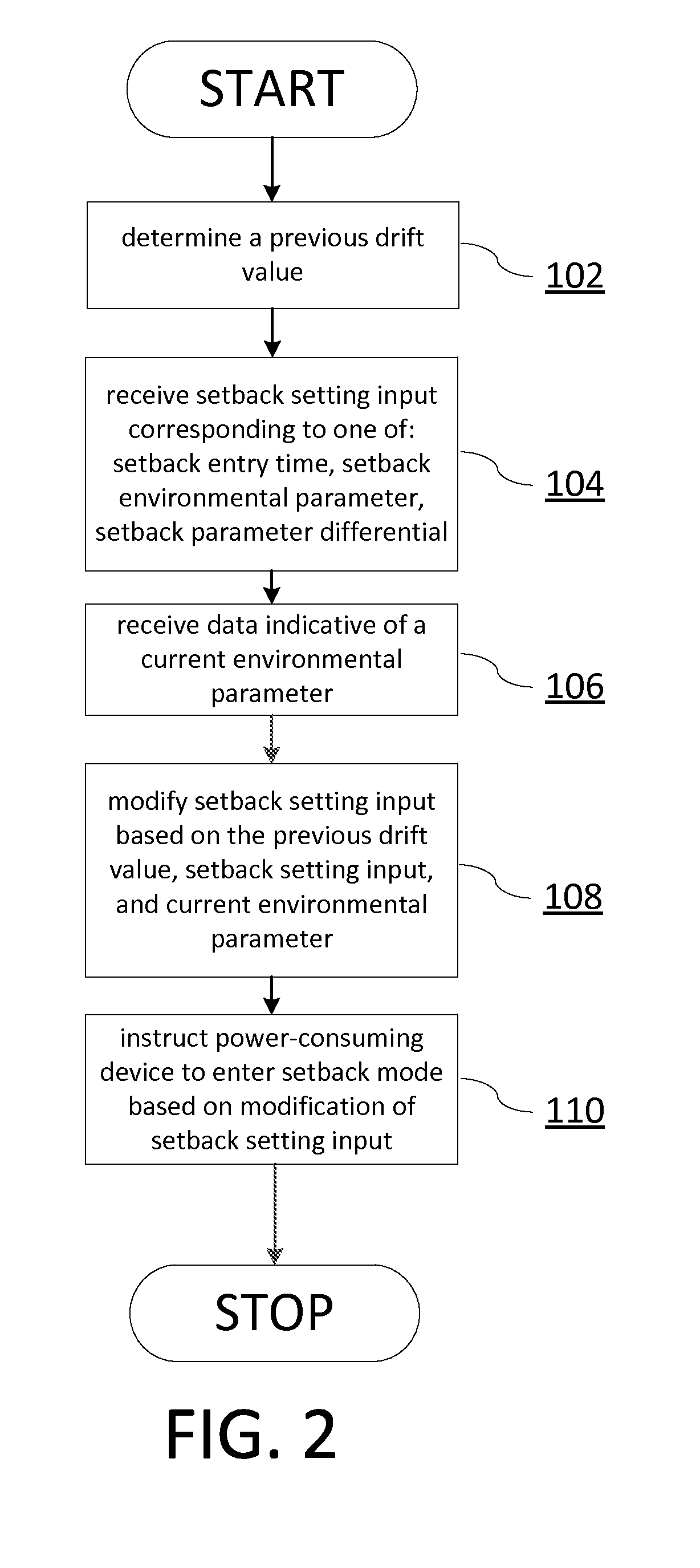Controlling the setback and setback recovery of a power-consuming device
a power-consuming device and control technology, applied in the direction of program control, heating types, instruments, etc., can solve the problem of power-consuming devices being “setback” to reduce the level of operation, and achieve the effect of improving the level of recovery
- Summary
- Abstract
- Description
- Claims
- Application Information
AI Technical Summary
Benefits of technology
Problems solved by technology
Method used
Image
Examples
example 1
[0056]This example illustrates the calculation of a setback for HVAC equipment according to the first embodiment of the invention. The temperature Drift Value can be calculated according to Equation 1:
TemperatureDriftValue=ΔTempΔTimeEq.1
Where ΔTemp is the temperature change from when the HVAC equipment turns off until when it is required to turn on again. The ΔTime (in minutes) is the duration of ΔTemp. For purposes of the present example, assume:
[0057]Cool set point=75° F.
[0058]Unoccupied entry time=7:00 pm
[0059]Setback entry temp differential=3° F.
[0060]Previously calculated temperature drift value=0.05
[0061]Specific temperatures are provided for example, but, in various embodiments of the invention, the temperatures chosen could be any temperature in a range of temperatures suitable for the operating conditions, for example, any temperature between 0° F. and 200° F., or any sub-range of temperatures therein, for example, 50° F. to 100° F., or 70° F. to 75° F.
[0062]The HVAC equipm...
example 2
[0065]This example illustrates the control of setback recovery for HVAC equipment according to the second embodiment of the invention. In this example, the data received by the system for controlling setback recovery are as follows:
[0066]Target space temperature=74° F.
[0067]Target recovery time=7:00 am
[0068]Zone temperature=68° F.
[0069]Previous setback recovery performance=5° F. in 20 minutes
[0070]Specific temperatures are provided for example, but, in various embodiments of the invention, the temperatures chosen could be any temperature in a range of temperatures suitable for the operating conditions, for example, any temperature between 0° F. and 200° F., or any sub-range of temperatures therein, for example, 50° F. to 100° F., or 70° F. to 75° F.
[0071]The time required for setback recovery is given by Equation 3, letting X equal minutes needed for setback recovery:
X=20min5°F.×74°F-68°F.=24minEq.3
[0072]Setback recovery for this HVAC unit would begin at 6:36 am.
[0073]The system for...
example 3
[0074]FIG. 2 illustrates an example of the first aspect of the first embodiment of the invention, which is a method of controlling a setback mode of a power-consuming device. In step 102, a previous drift value is determined. The drift value relates to changes over the time when the power-consuming device is not operating. For example, during the normal operation of a thermostat in a business environment, during, for example, the time period in which the site is open for business, when employees or customers are typically located at the site, during the hours of operation of the site, or other time period in which the site is occupied), the thermostat calculates a temperature drift value. This value is the change in temperature over time when the HVAC equipment is not operating. For example, the system and method can monitor when the HVAC equipment reaches a specified temperature or predetermined threshold (for example, a preset or predefined temperature) and shuts off or enters a s...
PUM
 Login to View More
Login to View More Abstract
Description
Claims
Application Information
 Login to View More
Login to View More - R&D
- Intellectual Property
- Life Sciences
- Materials
- Tech Scout
- Unparalleled Data Quality
- Higher Quality Content
- 60% Fewer Hallucinations
Browse by: Latest US Patents, China's latest patents, Technical Efficacy Thesaurus, Application Domain, Technology Topic, Popular Technical Reports.
© 2025 PatSnap. All rights reserved.Legal|Privacy policy|Modern Slavery Act Transparency Statement|Sitemap|About US| Contact US: help@patsnap.com



